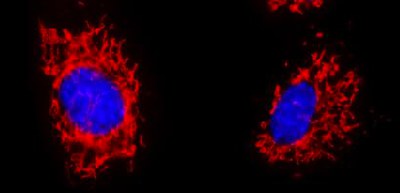
Mitochondrial fission factor plays an important role in mitochondrial antiviral signaling-mediated innate immunity
A group of researchers from Osaka University and Kurume University has discovered mechanisms for the anti-RNA virus response with mitochondrial antiviral signaling (MAVS) proteins.
Mitochondria are organelles derived from the endosymbiosis of bacteria and change their morphology while undergoing coordinated cycles of fission and fusion in response to intracellular signaling and the surrounding environment. Mitochondria produce adenosine triphosphate (ATP) using oxygen and regulate mitochondria signaling pathways, cell fate, and modulating innate immune responses.
MAVS is a mitochondrial outer membrane (OM) protein essential for the anti-RNA viral immune response, which is regulated by mitochondrial dynamics and energetics; however, the molecular link between mitochondrial metabolism and immunity and the reason why the immune response occurs on mitochondria are unknown.
This group found that Mff, a mitochondrial fission factor protein on mitochondria, has a critical function in MAVS-mediated innate immunity by sensing mitochondrial energy metabolism via AMPK* signaling.
*AMPK (adenosine monophosphate-activated protein kinase), an adenine nucleotide sensor that maintains energy homeostasis by directly phosphorylating proteins and is activated by an increase in the AMP/ ATP ratio.
The researchers established Mff knockout (KO) mouse embryonic fibroblasts (MEFs) and found that anti-RNA viral immune response was severely repressed in the absence of Mff and that Mff mediated the formation of active MAVS clusters on the OM to activate the innate immune response.
They also found that under mitochondrial dysfunction, Mff was phosphorylated by the cellular energy sensor AMPK, leading to the disorganization of MAVS clusters and repression of the acute antiviral response. (Phosphorylation plays an important role in intracellular signaling transduction: it alters the structural conformation of a protein, causing it to become activated.)
The researchers clarified that Mff quickly sensed ATP produced in mitochondria and manipulated the antiviral response via changes in the distribution of MAVS and that Mff regulated accumulated distribution of MAVS on mitochondria. Mff phosphorylation by AMPK repressed the antiviral response concomitant with the activation of mitochondrial fission.
MAVS is energized by Mff, which senses mitochondrial metabolism via AMPK for acute antiviral immunity. The researchers think that Mff switches from a strong and transient immune response under energy-rich conditions to a weak and continuous immune response under energy-starved conditions.
This study clarified the reason why the immune response occurs on mitochondria. This group’s findings will deepen the understanding of antiviral responses and clarify how viral infection causes serious complications. Underlying medical conditions such as obesity and diabetes are associated with increased risk of developing severe COVID-19 by the new coronavirus SARS-COV-2. This group’s achievements will lead to the development of treatment that can prevent serious diseases caused by viral infection.
Figure 1
Figure 2
The article, “MAVS is energized by Mff which senses mitochondrial metabolism via AMPK for acute antiviral immunity,” was published in Nature Communications at DOI: 10.1038/s41467-020-19287-7.
